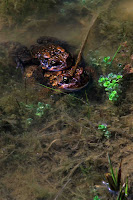 This week's Natural Division is the Rock River Hill Country, just to the East of the Wisconsin Driftless Division encompassing Stephenson County, most of Carroll and Ogle Counties, and parts of Winnebago, Lee, Whiteside and JoDaviess Counties.
This week's Natural Division is the Rock River Hill Country, just to the East of the Wisconsin Driftless Division encompassing Stephenson County, most of Carroll and Ogle Counties, and parts of Winnebago, Lee, Whiteside and JoDaviess Counties.This region of rolling, glaciated topography is drained by the Rock River. The soils of this division are thin and are either loess (wind-blown sediment) or glacial till. Two sections make up the division. The Freeport Section is underlain with dolomite and limestone. Outcrops and “dells” occur along streams. The Oregon Section (south central Ogle County) is underlain with sandstone that has formed bluffs, ridges, and ravines.
Prairie once occupied the larger expanses of upland while forests were equally abundant along watercourses. White pine, Canada yew, and yellow birch—northern forest relicts—can still be found in this division. Prairie knobs (islands of prairie that were either too hilly or too troublesome to farm) support downy yellow painted cup and profusions of pale purple coneflower. Castle Rock State Park and Nachusa Grasslands are representative sites of this division.
 Right now is a good time to look for pasque flowers as they are one of the early bloomers.
Right now is a good time to look for pasque flowers as they are one of the early bloomers.











